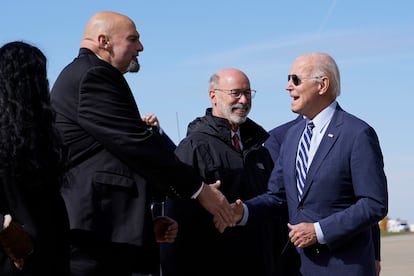Why the midterm elections feel more like round two of Biden vs. Trump
Although their names do not appear on any ballot for the November 8 vote, the rivals of the 2020 presidential race are locked in a bitter battle, portraying one another as ‘a threat to democracy’ and ‘unfit to lead America’


The 2020 presidential election candidates are locked in another bitter battle in the run-up to this year’s November 8 midterm elections. US President Joe Biden calls Donald Trump a “threat” to democracy, while Trump claims that the Democrat suffers from “cognitive impairment.”
Legislators from both chambers of Congress will stand for election on November 8. In the House of Representatives, all 435 seats will be contested, as they are every two years. In the Senate, a third of the seats will be decided. While US citizens will be heading to the polls to vote for lawmakers in November, the election goes beyond that. In a way, the 2022 midterms represent the second round of the 2020 presidential contest in which Joe Biden defeated Donald Trump (although the latter continues propagating the falsehood that he won).
The refusal to accept the outcome of the 2020 election has fueled political polarization in the United States. Both Trump and Biden have now entered the fray in their own distinctive ways. The president of the United States deliberately chose to give a speech last month on “the battle for the soul of the nation” right outside Philadelphia’s Independence Hall, where the founding fathers signed the Declaration of Independence and the US Constitution. In Biden’s speech, he asserted that “Donald Trump and the MAGA [Make America Great Again, Trump’s slogan] Republicans represent the extremism that threatens the very foundations of our Republic.”
Trump, 76, has opted to make personal attacks. At his rallies, the former president claims that Biden, who will turn 80 the week after the election, is “cognitively impaired” and “unfit to lead America.” That’s not an off-the-cuff remark: Trump has it in his written materials and repeats it at rally after rally; selected images of Biden faltering, slipping up or stumbling are even projected onto a giant screen.
While Biden accuses extreme Trump supporters of “semi-fascism,” Trump paints an apocalyptic picture of a country that has been taken over by “the radical left.” While Biden and Trump do not appear on any of the November 8 ballots, their names have been lobbed – like a grenade – into debates between legislative candidates in Georgia, Ohio and Florida.
Like a presidential election
“This election is behaving more like a presidential election than a midterm,” Charlie Cook, a political analyst and election trend expert and the founder of the Cook Political Report, said last week at an event in Washington. Four or five months ago, “it looked like it was going to be a bloodbath” for Democrats, he explains, because of Biden’s low approval ratings due to the country’s highest inflation levels in four decades.
Normally, trends don’t cause large swings in the midterm elections; usually, they serve as a referendum on the incumbent president. However, a series of conservative-majority Supreme Court rulings (on abortion, firearms, the environment, education and other issues); an unexpected string of Biden victories (including the passage of his signature climate, tax and health care bills); and Donald Trump’s return to the limelight (with the revelations of the January 6 inquiry commission into the assault on the Capitol, the FBI’s seizure of confidential documents in a raid of his Mar-a-Lago mansion, and his support for extremist candidates in the Republican primaries) have altered the dynamics of the upcoming election.
All told, the economy, particularly rampant inflation, remains the voters’ primary concern. “The outcome for Republicans is not going to be as good as they anticipated a few months ago, but it’s not going to be as good for Democrats as they expected a few weeks ago,” Cook summarizes.
Trump is still very popular among Republicans (“about 50% of Republican primary voters would jump into the Grand Canyon if Donald Trump asked them to,” Cook jokes), but he may scare away the independent and moderate voters who will determine the outcome. Cook estimates that about 45% of voters strongly identify with each party and will be heavily mobilized. In today’s polarized climate, “no Republican will vote for a Democrat and no Democrat will vote for a Republican. That’s a thing of the past,” he contends. So, the outcome depends largely on the 10% in the middle, independents who are in the crosshairs of both parties.
Polls show that voters in this election prioritize the economy over threats to democracy, and that they are more concerned with immigration than abortion. That’s bad news for the Democrats. Polls say that the party has all but lost the House of Representatives. Because of partisan gerrymandering, there are only about 30 competitive races out of the 435 seats up for election. If each party wins the seats they are expected or favored to win, Democrats would need to carry 80% of the most tightly contested districts to prevent a Republican victory; that outcome would be something of a miracle. Republican control of Congress’s lower chamber would be enough for the party to make the second half of Biden’s term a living hell.

The battle for the Senate is much more competitive. There are four key races in Pennsylvania, Georgia, Wisconsin and Nevada. Four other contests in Ohio, North Carolina, New Hampshire and Arizona remain tossups. Polls show that the Democrats are favored to hold on to the 50-50 tie in which the vice president, Kamala Harris, casts the deciding vote.
Trump and Biden have had very different campaigning styles. While Trump has held numerous rallies that are largely scripted (and repeated verbatim at each stop), Biden has used the visibility of his office for public appearances and events, but he has not held a public rally for weeks. He has attended party fundraisers around much of the country, but those have been small closed-door events. Some Democratic candidates in key constituencies have preferred to keep their distance from the president, and Biden has focused most of his efforts on Pennsylvania, a key state.
This Thursday, Biden returned to Philadelphia to campaign for Pennsylvania Senate candidate John Fetterman, first at an official event and then at a closed-door reception. This time, Biden did not go to Independence Hall’s small democracy-themed park, where tourists line up to take their pictures with the cracked Liberty Bell. Now an attraction, it once summoned citizens to hear the reading of the Declaration of Independence and later became an abolitionist symbol. Now, one is tempted to see the bell’s famous crack as a metaphor for American democracy.
Tu suscripción se está usando en otro dispositivo
¿Quieres añadir otro usuario a tu suscripción?
Si continúas leyendo en este dispositivo, no se podrá leer en el otro.
FlechaTu suscripción se está usando en otro dispositivo y solo puedes acceder a EL PAÍS desde un dispositivo a la vez.
Si quieres compartir tu cuenta, cambia tu suscripción a la modalidad Premium, así podrás añadir otro usuario. Cada uno accederá con su propia cuenta de email, lo que os permitirá personalizar vuestra experiencia en EL PAÍS.
¿Tienes una suscripción de empresa? Accede aquí para contratar más cuentas.
En el caso de no saber quién está usando tu cuenta, te recomendamos cambiar tu contraseña aquí.
Si decides continuar compartiendo tu cuenta, este mensaje se mostrará en tu dispositivo y en el de la otra persona que está usando tu cuenta de forma indefinida, afectando a tu experiencia de lectura. Puedes consultar aquí los términos y condiciones de la suscripción digital.
More information
Archived In
Últimas noticias
Most viewed
- Sinaloa Cartel war is taking its toll on Los Chapitos
- Oona Chaplin: ‘I told James Cameron that I was living in a treehouse and starting a permaculture project with a friend’
- Reinhard Genzel, Nobel laureate in physics: ‘One-minute videos will never give you the truth’
- Why the price of coffee has skyrocketed: from Brazilian plantations to specialty coffee houses
- Silver prices are going crazy: This is what’s fueling the rally










































